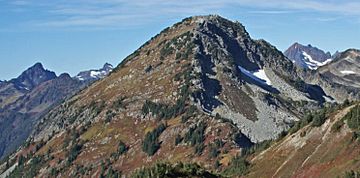Granite Mountain (Whatcom County, Washington) facts for kids
Quick facts for kids Granite Mountain |
|
|---|---|

Granite Mountain, southeast aspect
|
|
| Highest point | |
| Elevation | 6,692 ft (2,040 m) NAVD 88 |
| Prominence | 648 ft (198 m) |
| Geography | |
| Location |
|
| Parent range | North Cascades |
| Topo map | USGS Mount Sefrit |
| Climbing | |
| Easiest route | Scramble |
Granite Mountain is a tall mountain peak in the North Cascades mountain range. It stands about 6,692 feet (2,040 meters) high. You can find it in Whatcom County, Washington state, in the U.S.. It's part of the Mount Baker Wilderness, which is a special protected area. This mountain is managed by the Mount Baker-Snoqualmie National Forest. Water from Granite Mountain flows into the Fraser River and the Nooksack River. Granite Mountain is located about 1.7 miles (2.7 km) south of Mount Chardonnay. It is also 1.2 miles (1.9 km) northwest of Hannegan Peak.
Contents
Mountain Weather: The Climate of Granite Mountain
Granite Mountain is in a place with a "marine west coast climate." This means it's near the ocean, so the weather is often mild and wet. Most of the weather systems start over the Pacific Ocean. They then travel northeast towards the Cascade Mountains.
How Mountains Affect Weather
When these weather systems reach the North Cascades, the mountains force the air to rise. This process is called Orographic lift. As the air goes higher, it cools down. This causes the moisture in the air to turn into rain or snow. Because of this, the western side of the North Cascades gets a lot of rain and snow. This is especially true during the winter months.
Temperatures and Snowfall
Because of the ocean's influence, the area rarely gets very cold or very hot. Temperatures usually stay between 0°F (-18°C) and 80°F (27°C). In winter, it's often cloudy. But in summer, high pressure systems over the Pacific Ocean bring clear skies. The snow in this region tends to be wet and heavy. This can sometimes lead to a high risk of avalanches.
The Story of the Mountains: Geology of Granite Mountain
The North Cascades are known for their very rugged landscape. They have sharp peaks, long ridges, and deep valleys carved by glaciers. The way the land looks today was shaped by huge geological events that happened millions of years ago. These events created the big changes in height and the different climates across the Cascade Range.
How the Cascades Formed
The Cascade Mountains began to form millions of years ago, during the late Eocene Epoch. At that time, the North American Plate was slowly moving over the Pacific Plate. This movement caused many volcanic eruptions. Also, small pieces of the Earth's crust, called terranes, came together. These pieces helped create the North Cascades about 50 million years ago.
The Power of Glaciers
During the Pleistocene period, which was over two million years ago, glaciers repeatedly moved across the land. As they moved, they scraped and shaped the landscape. They left behind piles of rock and debris. The U-shaped valleys you see in the rivers today were formed by these glaciers. The combination of the land pushing upwards (called orogeny) and cracks in the Earth's crust (called faulting) along with the glaciers, created the tall peaks and deep valleys of the North Cascades.



